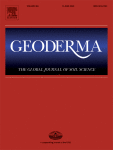View Item
- xmlui.general.dspace_homeCentros Regionales y EEAsCentro Regional Patagonia SurEEA EsquelArtículos científicosxmlui.ArtifactBrowser.ItemViewer.trail
- DSpace Home
- Centros Regionales y EEAs
- Centro Regional Patagonia Sur
- EEA Esquel
- Artículos científicos
- View Item
Changes in soil organic matter associated with afforestation affect erosion processes: the case of erodible volcanic soils from Patagonia
Abstract
Large areas of the Patagonian Andean Region with high potential for planting fast-growing exotic conifers, based on the volcanic nature of its soils, are affected by erosion processes. This study aimed to analyse the effects of Pinus ponderosa afforestation on soil organic matter (OM) fractions in non-allophanic volcanic soils and to determine the relationship between organic matter, soil aggregates and erosion processes. The study was conducted along a
[ver mas...]
Large areas of the Patagonian Andean Region with high potential for planting fast-growing exotic conifers, based on the volcanic nature of its soils, are affected by erosion processes. This study aimed to analyse the effects of Pinus ponderosa afforestation on soil organic matter (OM) fractions in non-allophanic volcanic soils and to determine the relationship between organic matter, soil aggregates and erosion processes. The study was conducted along a forested hill slope showing different soil properties according to slope position. OM fractions and aggregate size fractions under different dispersion forces were analysed on 0–5 cm soil samples in rangelands and in 14- and 24-year old plantations on steep and gentle slopes. Simulated rainfall assays were performed to assess
soil erodibility; OM and granulometry of sediments were also studied. Results showed that OM contents, mainly OM labile fractions (i.e., particulate OM, and OM associated with macro and large microaggregates), soil aggregation and the formation of very stable microaggregates were enhanced in the afforested soils. However, soil changes varied depending on the initial soil OM contents and on the age of the plantation, with more erratic and smaller changes in most fertile soils. Although potential erosion rates are lower in plantations than in rangeland soils, the high OM enrichment rates found in sediments imply a high OM loss when the soils remain uncovered. Erosion processes in afforestation involve the removal of microaggregates rich in OM and silt fractions, while in
the rangelands, coarse and very coarse sand single particles are lost. Afforestation replacing degraded rangelands may be a way to control erosion in these highly erodible volcanic soils, as long as the soil remains covered. Otherwise, the loss of soil enriched in OM from the superficial soil could favour soil carbon depletion.
[Cerrar]

Author
La Manna, Ludmila;
Tarabini, Manuela;
Gomez, Federico Antonio;
Rostagno, Cesar Mario;
Fuente
Geoderma 403 : 115265 (2021)
Date
2021-06-17
Editorial
Elsevier
ISSN
0016-7061
Formato
pdf
Tipo de documento
artículo
Palabras Claves
Derechos de acceso
Restringido
 Excepto donde se diga explicitamente, este item se publica bajo la siguiente descripción: Creative Commons Attribution-NonCommercial-ShareAlike 2.5 Unported (CC BY-NC-SA 2.5)
Excepto donde se diga explicitamente, este item se publica bajo la siguiente descripción: Creative Commons Attribution-NonCommercial-ShareAlike 2.5 Unported (CC BY-NC-SA 2.5)

